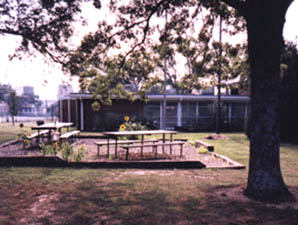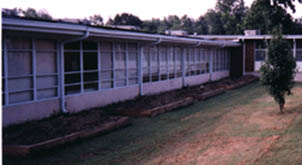|  
Education  Ava Ava  Ava Outdoor Classroom Ava Outdoor Classroom Ava Outdoor Classroom  The Ava School District is developing four small Outdoor Education sites contiguous to the elementary school and one 20 acre plot near the playing fields just outside town. The project has begun with the four areas on the elementary grounds. The Ava School District is developing four small Outdoor Education sites contiguous to the elementary school and one 20 acre plot near the playing fields just outside town. The project has begun with the four areas on the elementary grounds.
They are: 1) a bog-dry creek area and 2) a garden area outside the library, both on the south side, 3) a shade area on the west side and 4) a fenced-in garden area on the north of the school. Construction and Plans The school will construct a wheelchair accessible sidewalk with a ramp and a platform for viewing the bog, a large sandbox for math activities and outdoor art connected with conservation, and a dry creek bed. There will be bird and animal houses and feeding stations. Seventeen garden beds are planned, five made of landscape timbers and twelve of old tractor tires, to be used for learning and practicing good farming, gardening and conservation methods. Six sets of tables and benches will be installed, to be used as instructional areas. In addition, project partners plan to plant a number of indigenous trees and plants, which are expected to attract and provide habitat for indigenous wildlife. There will be three gardens specifically designed for butterflies. The school plans to set up a weather station in the fenced garden area. Interdisciplinary Curriculum The outdoor classroom areas will be used primarily by the elementary school. Middle and high school students will also assist and participate, as will members of the community. All activities in the outdoor areas will be preceded by or included in lessons about conservation and ecology. Teachers will design curriculum for use of the outdoor areas that will enhance what they are already studying in their classrooms and will be interdisciplinary, covering objectives from all four of the Show-Me Standards goals, as well as all six content areas. The project will enhance the use of the school grounds by students, staff and community and promote awareness, appreciation and conservation of natural resources.  Active, hands-on learning (identifying, analyzing, observing, comparing, measuring, collecting data and making charts and graphs, conducting research, investigation, writing, and working together) will provide experiences which will be a springboard to success beyond the classroom. Some concepts and skills can be particularly well taught through the development and utilization of an outdoor classroom. We have identified 26 (of the 33) objectives under the Show-Me Standards goals and 21 (out of 40) of the objectives in the six content areas which will be strengthened through student involvement in this project. Active, hands-on learning (identifying, analyzing, observing, comparing, measuring, collecting data and making charts and graphs, conducting research, investigation, writing, and working together) will provide experiences which will be a springboard to success beyond the classroom. Some concepts and skills can be particularly well taught through the development and utilization of an outdoor classroom. We have identified 26 (of the 33) objectives under the Show-Me Standards goals and 21 (out of 40) of the objectives in the six content areas which will be strengthened through student involvement in this project.
Activities Here are examples of activities that may occur through utilization of the Outdoor Classroom, correlated to meet the Show-Me Standards: Development of the Wetland Study Area (bog/dry creek): Students will first identify the need to design the area so that it will meet a set of specific goals by watching a video about the development of bog gardens, reading about bogs and wetlands and searching the internet for information about bogs. They will then thoroughly observe and record information on charts and graphs about the bog /dry creek area as it presently exists at varying stages of ground wetness. The preliminary ideas for the development and use of the area will need to be understood and their feasibility analyzed against the data collected. Proposals will then be written by small groups as to how to develop the area based on these preceding steps. They will map the area, showing it as it is now and as they want to see it. The proposals will be shared, feedback received, and revisions made, with this process repeated until one approach to the development of the area is reached. Class Garden Beds Each class involved will have responsibility for a garden bed. The class and teacher will select a focus for their bed. For example, one class may choose to grow sunflowers and feed birds from their harvested seeds. Many skills and content areas will be included in accomplishing these goals. They will read about types of sunflowers, share information, make decisions about what types to grow, order seeds, prepare and maintain their bed, harvest seeds and quantify their harvest, place seeds grown in feeders and observe, and share their results with others. At the same time, they will incorporate this interest in sunflowers, gardening and feeding birds into creative writing and art projects, also observing and recording data as their plants grow. Further, students might set-up and observe differences in plant growth under varying conditions and repeat trial for comparison. 
Source: excerpted by Hank Dorst from the grant application for funding the outdoor classroom. |

